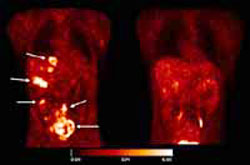A marker for new blood vessel formation in tumors

ávâ3 integrin expression in tumors. (Photo: Roland Haubner, et al.)
In a paper in this month’s freely-available online global health journal PLoS Medicine, Roland Haubner and colleagues describe how a compound they have developed can be used together with highly sensitive positron emission tomography (PET) scanning to measure the amount of new blood vessel growth in some tumors.
New blood vessel growth – angiogenesis – is important for the growth of tumors; several drugs target angiogenesis specifically. The compound previously developed by Haubner and colleagues is a fluorine-labeled glycopeptide, ([18F]Galacto-RGD), which binds tightly to a receptor – ávâ3 integrin -expressed in some tumors, especially in the blood vessels. As well as a role in angiogenesis, integrins are important in holding tumor cells together and connecting them with the extracellular matrix; what happens when these interactions break down is one of the keys to determining how tumors metastasize.
Haubner and colleagues’ work, in a mouse with human melanoma and in a small study of patients with tumors including melanoma, suggests that the marker is truly reflecting the in vivo level of the integrin. Hence the marker could be used to identify tumors that express this marker, assess the degree of new vessel formation in tumors, and help in the planning and monitoring of anti-angiogenic therapies which target this integrin.
Media Contact
More Information:
http://www.plos.orgAll latest news from the category: Life Sciences and Chemistry
Articles and reports from the Life Sciences and chemistry area deal with applied and basic research into modern biology, chemistry and human medicine.
Valuable information can be found on a range of life sciences fields including bacteriology, biochemistry, bionics, bioinformatics, biophysics, biotechnology, genetics, geobotany, human biology, marine biology, microbiology, molecular biology, cellular biology, zoology, bioinorganic chemistry, microchemistry and environmental chemistry.
Newest articles

High-energy-density aqueous battery based on halogen multi-electron transfer
Traditional non-aqueous lithium-ion batteries have a high energy density, but their safety is compromised due to the flammable organic electrolytes they utilize. Aqueous batteries use water as the solvent for…

First-ever combined heart pump and pig kidney transplant
…gives new hope to patient with terminal illness. Surgeons at NYU Langone Health performed the first-ever combined mechanical heart pump and gene-edited pig kidney transplant surgery in a 54-year-old woman…

Biophysics: Testing how well biomarkers work
LMU researchers have developed a method to determine how reliably target proteins can be labeled using super-resolution fluorescence microscopy. Modern microscopy techniques make it possible to examine the inner workings…





















